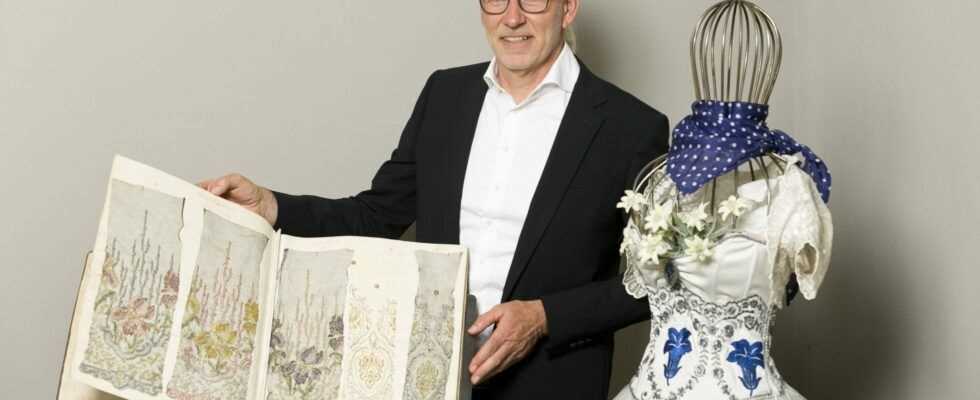In his series “The Last”, author Robert Schneider portrays people who pursue an ancient craft. This week he visited the sticker Markus Hämmerle in Lustenau.
In his series “The Last”, author Robert Schneider portrays people who pursue an ancient craft. This week he visited the sticker Markus Hämmerle in Lustenau.
A very well-groomed man my age with white hair tied in a braid and black horn-rimmed glasses opens the door to his company for me. The man who doesn’t have a single gram of fat exudes cosmopolitanism, I can feel that straight away. It’s like I’m chasing after Karl Lagerfeld. The man turns on the lights. The company is empty. Obviously everyone on vacation. He himself goes into the kitchen, makes coffee for me and the photographer.
Meanwhile I look around. A breathtakingly beautiful dress with blue-silver applications is a showpiece in the office. Everywhere on the walls photographs of lingerie in the finest embroidery. Later the man will tell me that his company made lingeries for Madonna and “Victoria’s Secret”, but also embroidered “postage stamps” for the Vatican and the Principality of Liechtenstein.
His name is Markus Hämmerle and is the owner of the traditional embroidery “Hämmerle & Vogel”, a company that has outlasted all the changeability of the market, which few have succeeded in doing. Everything started very differently. “I was a windsurfer and even took part in a World Cup,” says Hämmerle. “One day my father called me into his office: How do you want to earn a living? About surfing? That’s how I became a sticker. “
From grandfathers and pantographs
A father-son conflict can be guessed at, as it is so typical for our generation. But from the beginning. Hämmerle, who turned sixty last week, gives me a crash course in embroidery history, and I can tell that he has done this many times before, when visitors came, more unsuspectingly. He talks about the beginnings, how his grandmother and her sister cycled to Switzerland every day and made hand embroidery there. How his grandfather, who owned a so-called “pantograph”, where the movement between two needle pricks was still laboriously transmitted with the help of a “cork’s bill”, fell in the war, which is why the machine stopped because no one else could operate it. How his father was one of the first to obtain a special permit for his embroidery business from the Chamber of Commerce …
In fact, the history of embroidery is closely interwoven with technical progress over the past 130 years. When there was no threading machine (around 1890), threading was done by hand. “Satin stitch machines” had up to 1,000 needles that children and women had to thread for six to eight hours a day. It was a long way from the “shuttle embroidery machine” with punched cards, as Markus’ father bought it, to the modern machine that works with laser control. A path that, by the way, also reflects the history of fashion, even a piece of religious history. “In the 60s and 70s, baptism and communion dresses were still pregnant, later ball dresses and today we are specialists in, among other things, embroidered underwear, we work with recyclable materials.”
He has the sticker gene, Markus Hämmerle, and tells of a coup he had with an Armenian shoe manufacturer in France, who first cheekily dismissed the idea of embroidering leather shoes. “But two weeks later three distinguished gentlemen stood at my door. I borrowed my father’s jaguar. We went to a fine restaurant and in the afternoon the deal was perfect. A five-year collaboration with the noble school manufacturer Stéphane Kélian has emerged. As a result, we also embroidered shoes for Jean Paul Gaultier. “
Embroidery secured in the safe
He still gets goose bumps today when he thinks back when he called the philately department of the Austrian Post and made the proposal to produce textile, embroidered postage stamps. He had expected a “have the honor and goodbye!” The result was an order for the production of an edelweiss brand, “designed by my wife Iris”, with a circulation of 400,000. “That was under the care of the Austrian state printing company. We actually embroidered cash. The daily production was locked in a bank vault at night and later transported to Vienna with security transports. “
Markus Hämmerle tells with passion. For example, how he presented a stamp in the Vatican, marched into the papal palace with the Swiss Guard, his business ran at full speed for the whole Christmas holidays because the people in Rome really wanted to have the stamp by February.
“I tuas no brutal gearn”, he says in conclusion, and then in a urbane way in High German: “Success is when life has been successful. But you don’t have to write that. ”I write it because it’s a beautiful sentence that is true.
